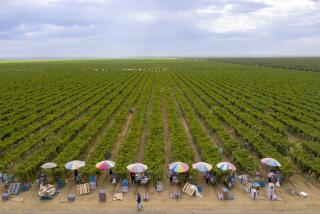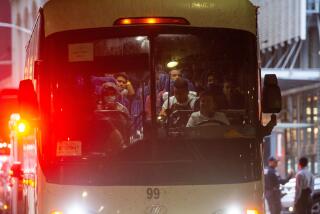A town that wants illegal immigrants
Lindsay, Calif. — THE IMMIGRATION debate can get pretty sloppy and emotional in the abstract, but not here in this Central Valley town that can’t afford to let simplistic rhetoric overshadow facts. Last month’s devastating citrus freeze has put Lindsay, population 11,185, in dire economic straits; but its pragmatic response to the crisis sets an example for the rest of the nation.
The packing houses here in the heart of California’s citrus belt are generally hopping the first week of February. In a normal year, the two LoBue Bros. plants would be open 50 to 60 hours a week, employing 230 workers and processing up to 7,000 bins of oranges. But after last month’s freeze, the third since 1990, LoBue is operating at quarter speed. One plant is shut down, and the other is running just 20 hours a week. About 60% of the employees are off work.
After the first of March, there will be a brief spurt of activity, when agricultural officials determine which remaining oranges are frost-free and good enough to go to market. But by mid-April, when the good fruit runs out, all activity, from picking to trucking, will stop, and there will be no more work until late October. If workers leave town — and if those who stay are jobless — the city’s economy will collapse.
Seeking to avert an economic meltdown, officials have come up with an innovative plan to not only address joblessness but to keep the workforce from abandoning the town. Invoking the memory of Franklin D. Roosevelt’s Depression-era Works Projects Administration, the city’s elected officials — all of whom are Republicans — are seeking federal aid to put the idle labor force to work on local improvement efforts.
The fact that a large-yet-undetermined percentage of farm laborers — particularly pickers — are illegal immigrants does not deter local officials from seeking aid for them. Unlike other parts of the U.S. where undocumented immigration is a divisive issue, in Lindsay it is a matter of economic survival.
In a city-owned youth club on Sweetbriar Avenue, officials and local nonprofits have set up the Lindsay Freeze Relief Center, where displaced workers can apply for food, clothing, rental and utility assistance, as well as for temporary employment. In its first week of operation, more than 1,200 workers applied. Last Tuesday afternoon, I watched a stream of Mexican immigrants stroll into the center, some with children in tow, looking for assistance.
Longtime Lindsay residents who have raised children here were likely to say that they would weather the hardship no matter what. But recent immigrants said they would leave if they didn’t find work soon. “I’m thinking of leaving,” said 27-year old Maria Cisneros from the Mexican state of Michoacan. Where to? “Wherever there’s work,” she replied.
Growers and labor contractors will tell you that the area can’t afford to lose more workers. Some say that the current farm labor shortage — of as much as 50% — made the effects of last month’s freeze worse than it otherwise would have been. The recent crackdown on the border is being felt in this corner of the Central Valley.
“If we had more workers, we could have picked up to 75% of the crop,” said Lindsay-born labor contractor Alice Gutierrez. Growers had a week’s notice that the freeze, which caused an estimated $418 million in damage in Tulare County alone, was imminent.
Lindsay Mayor Ed Murray says the worst-case scenario is that the town could lose up to 30% of its labor force. “Regardless of whether they’re legal or illegal, it’s imperative that we have workers here for next year’s harvest,” he said. Murray hopes that the federal government will find a way to not only aid his town’s residents in the short term but to legalize the undocumented.
Given the divisiveness of the national debate, it is remarkable how many people here recognize the need for the workers who have come to this country illegally. Perhaps not surprisingly, business people, who already are feeling the pain of the freeze, are most likely to make the case.
“It helps all of us,” said 71-year-old Bill Martin, who owns a tire shop in town. “I don’t particularly care for illegal people in the U.S., but if they come in and want to buy a tire, I’ll accommodate them. If you don’t have people come, you won’t get the fruit picked. And if the fruit doesn’t get picked, nobody will have money to buy anything.”
Of course, Lindsay is not the only town to try to soften the blow to farmworkers. But what makes its response extraordinary is that city officials are not just looking to solve residents’ or employers’ immediate needs. They have identified seven public works projects that could benefit from temporary labor — from building a new soccer field to clearing alleyways and constructing a library.
“We’re trying to be farsighted about this and improve the community in the long term,” said Kindon Meik, the city’s personnel director. “When people invest their labor, they are more vested in the town.”
I suspect that much of Lindsay’s innovative spirit comes from the knowledge that it has survived much worse. In 1992 — two years after a catastrophic freeze — residents gathered in a local park to bury a coffin containing symbols of the town’s financial troubles.
That decade, Lindsay saw its share of white flight and the complete ethnic transformation of the population, which is now 78% Latino. But today, it is clear that the town has thus far survived the transition, and three of five City Council members are Mexican American. Consequently, race doesn’t appear to play a big role in the city’s approach to issues, including immigration. And so, stripped of the racial and broader ideological implications of the problem before them, Lindsay officials are free to do what they think is right for their little town. Or as citrus grower and Tulare County Supervisor Allen Ishida put it, “We don’t have the luxury of not being practical.”
More to Read
Sign up for Essential California
The most important California stories and recommendations in your inbox every morning.
You may occasionally receive promotional content from the Los Angeles Times.










